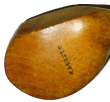
|
Registration Edit profile catalogue auction shopping cart shipping history makers search faq news links about contact |

Clubmakers
Thomas P Waggott
Musselburgh/Aberlady
Thomas Pilling Waggott was born in Port Glasgow in 1859 to William Waggott and his wife, Catherine née Anderson.
Thomas’s death certificate describes him as a retired tanner which reflects the ‘double life’ he led. We think of him as a Musselburgh clubmaker but he was in his 30s before he came to the town.
As a tanner, he followed the occupation of his father, an Englishman who was working in this capacity in Port Glasgow when Thomas was born and at the time of the 1861 census. By the 1881 census Thomas is out on his own, working as a tanner in Edinburgh and living in Earl Grey Street just off Lothian Road while his father is unemployed and living with the rest of the family on the outskirts of Dundee. Presumably William had worked as a tanner in Arbroath prior to Thomas’s birth as Thomas’s three sisters were born in the town. The first mention of the family in Musselburgh is on the 1891 census, living in Golf Place, with William retired and Thomas described as a tanner foreman.
As I have not seen a long-nose club with Waggott’s name on it I imagine this is the time he started to make clubs, at least commercially. But, by the end of the year, he was off to the Ilkley club in Yorkshire to be their professional and clubmaker, ‘a noted clubmaker’, the Leeds Mercury called him. He was up in Edinburgh on 1 June 1892 to marry Annie Whitelaw Howden. The Ilkley connection only lasted until January 1893 when he returned to Scotland and the business ramped up but with some moving around Edinburgh and East Lothian, at least with residence (the shop in Aberlady was in existence from 1893), his three children being born in Newington in 1893, Inveresk in 1895 and Aberlady in 1898. Part of the reason for this may be that the council refused to lease him land at Goose Green beside the Musselburgh course in 1894 and 1895 (his son William eventually securing premises here). He advertised a mail-in and return service for remaking golf balls and the sale of unbreakable clubs, ‘the cheapest and best in the trade’, hole cutters, tins and flags. These ads ran in Glasgow and Edinburgh but also in England in St Helens and Warrington newspapers, for example.
He was clearly a good player as well as a clubmaker. In April 1894 he played the best ball of two Musselburgh club members and teed on the face of a watch at every hole. He went round in bogey (41) and the watch was unmarked.
However, he had not abandoned the tanning trade; he presumably never wanted for grips. In 1901 he was back in Arbroath and described on the census as Tanner (Manager). At least from 1902 he was operating a clubmaking business in the town but he was moving again in 1903 with a property for lease in Arbroath advertised as ‘presently occupied by Mr T P Waggott, golf-club maker’. He donated six clubs for sale at the 1902 bazaar to raise the funds to complete the purchase of the Elliot links that year and played for Arbroath against the Dundee Advertiser golf club that year.
It was back to Aberlady in 1903. The shop in Aberlady disappeared from Slater’s Directory in 1915 but this may have been just as a result of the war. Tom’s eldest, William, went away on war service in 1916, and it certainly operated as a clubmaker’s shop until William’s death in 1947. It is not apparent to me when the authority in the business shifted from father to son. I have not seen any clubs marked T Waggott or T P Waggott from after 1920. Some could be between 1915 and 1920 but, equally, the war could mark the end of Tom’s running of the business. His clubs were marked either Aberlady or Musselburgh.
Tom was an innovative clubmaker with several patents to his name including the 1893 cleek with a shortened hosel and a piece of steel lodged in a slit at the bottom of the shaft touching the head. This, it was said, aided the spring of the club and added distance. He clearly took oher clubmakers' patents very seriously (which is more than can be said for some makers) for, having invented a cleek with a drill-through hosel, he voluntarily withdrew it from sale lest it infringe Carruther's patent.
Thomas died in Aberlady on 28 July 1941.
![]() Search the catalogue for
clubs by this maker
Search the catalogue for
clubs by this maker
site design dmc ltd | © 2000-2024 Antique Golf Clubs from Scotland